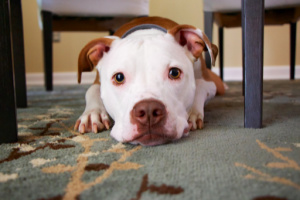
This pup can’t wait for the chance to practice what he learned in group class last night.
If you practice between private lessons or group classes, you will progress quickly and develop a teaching relationship with your dog based on attention and play.
How to set up good practice sessions
Practice for 10-15 minutes per day.
Choose a time of day when you are in good spirits and your dog is awake.
Choose 1 or 2 exercises to work on. Do not try to practice everything your dog knows.
Begin with a warm up exercise. Get your dog excited and ready to work.
Move into exercises your dog knows. A dog knows an exercise when he gets it right at least 8 out of 10 times.
Graduate into new work in which you are showing your dog something new, or increasing the level of difficulty for exercises he knows.
End with easy exercises your dog can get right. Leave a little something for the next day’s session.
Keep the work fun. Do not work exercises in the same order and the same way day after day. Break up exercises with tug, fetch, or other forms of play.
If your dog becomes fatigued and makes multiple errors, ask for something very easy (even “Sit”) and quit.
As your dog gains experience and you have been training for a few months, extend the sessions to build stamina. Train for as long as seems productive, but stop before you and the dog become tired.
Work with the lowest value of food possible (kibble). Save high value foods (cheese, hot dogs) for high distraction environments, new skills, or exercises that are challenging.
What to do if it’s not working
Reward effort, even if the dog’s attempt is imperfect. That said, tell your instructor if your dog’s effort greatly outweighs his accuracy.
Dogs get things wrong for several reasons. If he is confused, reteach the exercise. If afraid, change the environment just enough to decrease his fear. If distracted, use higher value food to gain his attention and/or change the environment. He may not be ready for the level of distraction present, but can manage if further away. If he thinks he may simply refuse, have a backup plan for what to do to enforce your cue. However, give him the benefit of the doubt. In the presence of food, when sufficiently hungry, and when the instructions are clear, most dogs are able to execute basic cues with accuracy.

